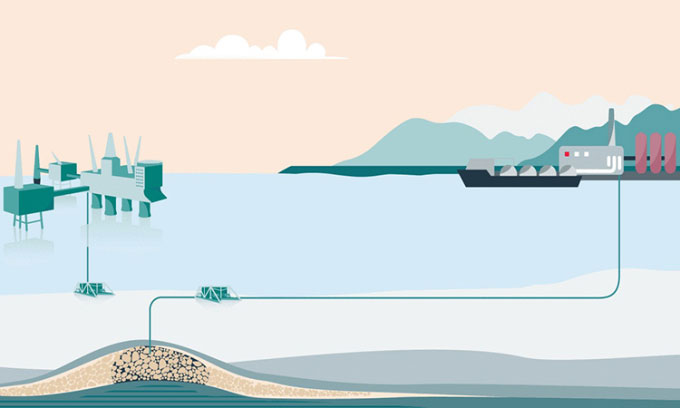Norwegian energy company Equinor proposed on June 29 to construct a CO2 transportation pipeline to the seabed of the country for permanent burial.
If implemented, this would be one of the largest carbon capture, transportation, and storage (CCS) projects in the world.
“The planned offshore pipeline is designed to transport between 20 to 40 million tons of CO2 per year, meeting the emerging CCS demand from various European industrial companies,” Equinor emphasized in a statement. This figure is equivalent to the emissions produced by 3 to 6 million people.
CCS is considered a viable solution for heavy CO2 industries as a way for them to continue operations despite increasingly stringent emission reduction measures aimed at combating climate change.

Simulation of the CO2 capture, transportation, and storage system under the seabed of Norway. (Photo: Equinor)
According to the proposal, the Belgian energy infrastructure company Fluxys will operate a facility in Zeebrugge, where CO2 will be collected from factories and ships docked at the port connected by pipeline.
Subsequently, the CO2 will be transported through another pipeline operated by Equinor under the North Sea. This pipeline will facilitate the permanent storage of CO2 beneath the seabed offshore of Norway.
The project is still in the feasibility study phase. Equinor and Fluxys are currently working with potential customers and hope to make an investment decision by 2025.
Grete Tveit, Senior Vice President for Low Carbon Solutions at Equinor, stated that the project has “the potential for large-scale decarbonization in heavy industries across Europe.”
Equinor is also involved in an ongoing project to store CO2 offshore from a Norwegian cement plant and other industrial facilities.
In its latest report, the United Nations stated that to limit global temperature rise to 1.5°C in accordance with the Paris Agreement, merely reducing greenhouse gas emissions is insufficient. The world will need to employ additional techniques to remove CO2 from the atmosphere and oceans.


















































